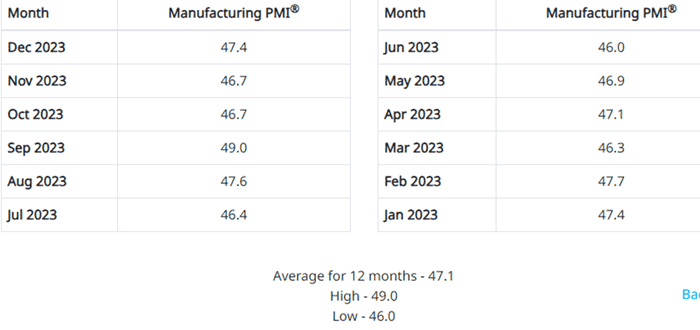The US Purchasing Managers Index (PMI) for December was released Wednesday by the Institute for Supply Management (ISM), and came at a level of 47.4, up a little from November, but still below the key 50 mark that separates US manufacturing expansion from contraction for the 14th straight month.
That as other measures such as the job numbers and Q3 GDPare more positive, as the economy continues to give mixed signals.
The PMI tracks closely but not exactly with the overall US economy. The December result showed the broader economy continued in contraction for a third month after one month of weak expansion preceded by nine months of contraction and a 30-month period of expansion before that.
A Manufacturing PMI above 48.7, over a period of time, generally indicates an expansion of the overall economy.
A similar story with the New Order Index, which remained in contraction territory at 47.1, 1.2 percentage points lower than the figure of 48.3 recorded in November, in a bad sign for future US manufacturing activity.
Other numbers from ISM for the month were mostly down or below the 50 mark.
An exception was the Production Index, with a reading of 50.3, a 1.8-percentage point increase compared to November’s figure of 48.5.
The Prices Index registered 45.2, down 4.7 percentage points compared to the reading of 49.9 November.
That means companies saw a decrease in the cost of components, materials and other inputs. This index (below 50 = falling prices) was not that many months ago above 80, as inflation took off.
In more economic bad news, the Backlog of Orders Index registered 45.3. While that was 6 percentage points higher than the November reading of a dismal 39.3, it means the order book of most companies is shrinking, with the level still well below the 50 mark.
“The Supplier Deliveries Index level of 47 is 0.8 percentage point higher than the 46.2 recorded in November. Supplier Deliveries is the only ISM index that is inversed, with a reading of above 50 indicating slower deliveries, which is typical as the economy improves and customer demand increases - or the reverse.
The Inventories Index decreased by 0.5 percentage point to 44.3, versus the November reading was 44.8, indicating inventory levels at companies are again decreasing.
“The US manufacturing sector continued to contract, but at a slightly slower rate in December as compared to November. Companies are still managing outputs appropriately as order softness continues.” commented Timothy Fiore, Chair of the Institute for Supply Management Manufacturing Business Survey Committee.
As always, the ISM report provides a graphic of the full PMI scores the last 12 months, which as can be seen shows the measure has been below the key 50 mark since November 2022, and it is now averaging just 47.1 over the past year.
US PMI Last 12 Months

Source: ISM
(See More Below)
|
CATEGORY SPONSOR: SOFTEON |
|
|
| |
| |
|
|
Just one of the 18 industry US sectors tracked by the PMI reported growth in December, which was primary metals.
As always, there were some interesting comments from PMI survey respondents.
“Business is slowing. Finished goods inventories are growing,” said one manager in the machinery sector.
Added one respondent in the chemicals sector, “Overall, order intake has picked up over the last quarter and a backlog of projects is beginning to accumulate.”
Finally, a manager in wood products sector noted that “Higher financing costs have diminished demand for residential investment. Customers are delaying a portion of their plans until borrowing costs are reduced. We are impacted with reduced new orders, diminished backlog of orders and uncertain short-term demand for products and services.”
Any reaction to the December PMI? Let us know your thoughts at the Feedback section below.
|